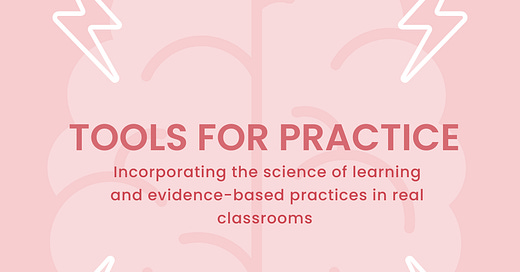Tools for Practice
How teachers and leaders are incorporating the science of learning in real life
This monthly feature is focused on the nitty-gritty, where the rubber meets the road in real classrooms. Each link takes you to one educator’s solution—a science-of-learning technique, resource, or practice. It gives on-the-ground details, straight from educators and leaders, of how educators incorporated it, how they tweaked it to suit their students’ needs, and how it’s working.
Tools for Practice is an encyclopedia for educators, leaders and even parents, filled with ideas on how to implement evidence-based techniques. Have a practice you’d like to share? Message The Bell Ringer or send an email!
* Incorporating retrieval practice into daily note-taking
In a high school Spanish class, taking notes gets an upgrade to improve students’ memory of what they learned. Read the solution here.
* A more explicit chemistry lab
How to use background knowledge, explicit instruction and other elements of cognitive science to design a better science lab. Read the solution here.
* Do your students *really* know the material?
Using the ‘Brain, Book, Buddy’ technique to make students aware of what they actually know. Read the solution here.
More from The Bell Ringer
* Subscribe to The Bell Ringer YouTube channel for interviews with experts in cognitive science and evidence-based teaching
* Check out the growing Resource Guide for books, podcasts and articles to help inform your knowledge
* Support The Bell Ringer’s mission of getting cognitive science and the science of learning to schools and the public. Get access to the entire archive, all the tools and resources, and the chat: become a paid subscriber!





Are you looking for specific strategies? I love the science of learning, but do you mean mainly evidence-based, as in "I can cite this approach with a research paper" kind of thing?